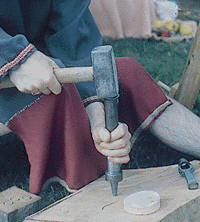| Gael Agus Gall...
information
We often get asked to explain what Living
History is all about. Essentially, we are endeavouring
to recreate a time from our past. (Click
here for Gaelic kit guidelines). Our chosen
time frame is the Viking Age in Ireland. The arrival
of the Vikings to Ireland in 795 AD signaled the
beginning of this age. They maintained a presence
in Ireland for over two hundred years. We generally
consider the Battle of Clontarf in 1014 AD to be
our finishing point, although there were still many
Viking influences in the country - particularly
in some of the coastal towns they had founded and
what was to become the nation's capital - Dublin.
Try and cast
your mind back a thousand years. The
day-to-day routine of most people was one
of hard work, aspects of which we
reproduce by demonstrations of spinning,
dyeing, weaving, woodwork and
leatherwork. Each members' clothing is
hand-made to patterns based on
archeological finds and manuscript
evidence and represents hours of research
and work. The food prepared on site is
also typical of the diet of the period.

The moneyer strikes coins
There are fun and games, too! Visitors
to our shows can try their hand at
"tafl" - a board game popular
amongst the Vikings. You can also try on
a mail shirt, and feel how heavy a real
broadsword is!
The weapons and
tools which we use on site are based on
archaeological finds and are constructed
of authentic materials. In the case of
battle display, these weapons are
specially blunted for safety purposes.
At all times our
aim is to re-enact for both ourselves and
the public what life would have been like
in Viking Age Ireland. The photographs on
the site show members of the group
engaged in aspects of their day-to-day
routine.
We take pride in
bringing our “inter-active”
Living History display to festivals and
event of all kinds throughout Ireland.
We delight in
giving people young and old the
opportunity to experience first-hand the
ways of our ancestors.
We are also keen to promote school
and museum visits as part of our ongoing educational
programme. If you would like to include Gael
Agus Gall in an event or show, please contact
us for more information.
 
The coins we make on site are
replicas of the original King Sitric
Silver Penny - the first coinage minted
in Dublin in 997 AD.
|

